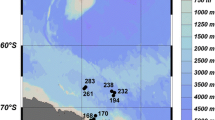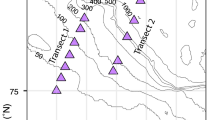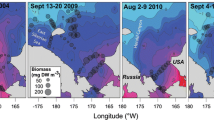Abstract
Zooplankton (meso- and macrozooplankton) distributions and biomass are poorly known in the Ross Sea despite their importance in energy transfer within food webs and biogeochemical cycles. Mesozooplankton abundance and biomass on the continental shelf are spatially variable and span two orders of magnitude during austral summer. Selected sub-regions (near the shelf break or ice shelf) show similar variability, suggesting that other processes, either oceanographic or biological, influence zooplankton on smaller scales. Biomass at one location (76.5° S, 172° E) was consistently elevated throughout January, although the causes of this “hotspot” were unclear. At a station near the ice shelf, abundance and biomass of the pteropod Limacina antarctica was very high. Zooplankton biomass at this location was sevenfold greater than any other station, and while the high biomass was driven by pteropod contributions, copepods were also abundant. Copepods dominated the mesozooplankton composition at all other stations, comprising 90 and 78% on average of the total abundance and biomass. Zooplankton biomass comprised on average 3.96% of the total particulate carbon (0–200 m) and was weakly correlated with chlorophyll and biogenic silica. We suggest that summer zooplankton growth and biomass, while linked to organic matter concentrations, are regulated by other factors (e.g., predation by crystal krill and Antarctic silverfish), as both grazers may be responsible for significant losses. Our data indicate that, contrary to other suggestions, summer zooplankton biomass and abundance in the Ross Sea are similar to those in other Antarctic coastal regions.




Similar content being viewed by others
References
Ainley DG (2007) Insights from study of the last intact neritic marine ecosystem. Trends Ecol Evol 22:444–445
Ainley DG, Ballard G, Dugger KM (2006) Competition among penguins and cetaceans reveals trophic cascades in the Ross Sea, Antarctica. Ecology 87:2080–2093
Ainley DG, Ballard G, Blight LK, Ackley S, Emslie SD et al (2010) Impacts of cetaceans on the structure of southern ocean food webs. Mar Mamm Sci 26:482–489
Ainley DG, Ballard G, Jones RM, Jongsomjit D, Pierce SD, Smith WO Jr, Veloz S (2015) Trophic cascades in the western Ross Sea, Antarctica: revisited. Mar Ecol Prog Ser 534:1–16
Ashjian C, Rosenwaks GA, Wiebe PH, Davis CS, Gallager SM, Copley NJ, Lawson GL, Alatalo P (2004) Distribution of zooplankton on the continental shelf off Marguerite Bay, Antarctic Peninsula, during austral fall and winter, 2001. Deep Sea Res II 51:2073–2098
Atkinson A, Siegel V, Pakhomov EA, Rothery P (2004) Long-term decline in krill stock and increase in salps within the Southern Ocean. Nature 432:100–103
Atkinson A, Ward P, Hunt EPV, Pakhomov EA (2012) An overview of Southern Ocean zooplankton data: abundance, biomass, feeding and functional relationships. CCAMLR Sci 19:171–218
Ballard G, Jongsomjit D, Veloz SD, Ainley DG (2011) Coexistence of mesopredators in an intact polar ocean ecosystem: the basis for defining a Ross Sea marine protected area. Biol Cons. doi:10.1016/j.biocon.2011.11.017
Comeau S, Ross J, Teyssié J-L, Gattuso J-P (2010) Response of the Arctic pteropod Limacina helicina to projected future environmental conditions. PLoS One. doi:10.1371/journal.pone.0011362
Davis CS, Gallager SM, Marra M, Stewart WK (1996) Rapid visualization of plankton abundance and taxonomic composition using the Video Plankton Recorder. Deep Sea Res I 43:1947–1970
Deibel D, Daly KL (2007) Zooplankton processes in Arctic and Antarctic polynyas. In: Smith WO Jr, Barber DG (eds) Polynyas: Windows to the World. Elsevier Press, Amsterdam, pp 271–332
Ducklow HW, Wilson SE, Post AF, Stammerjohn SE, Erickson M, Lee S, Lowry KE, Sherrell RM, Yager PL (2015) Particle flux on the continental shelf in the Amundsen Sea Polynya and Western Antarctic Peninsula. Elementa. doi:10.12952/journal.elementa.000046
Dunbar RB, Leventer AR, Mucciarone DA (1998) Water column sediment fluxes in the Ross Sea, Antarctica: atmospheric and sea ice forcing. J Geophys Res 103:10741–10760
Elliot DT, Tang KW, Shields AR (2009) Mesozooplankton beneath the summer sea ice in McMurdo Sound, Antarctica: abundance, species composition, and DMSP content. Polar Biol 32:113–123
Foote KG, Stanton TK (2000) Acoustical methods. In: Harris R, Wiebe PH, Lenz J, Skjoldal HR, Huntley M (eds) ICES zooplankton methodology manual. Academic Press, London, pp 223–258
Foster BA (1987) Composition and abundance of zooplankton under the spring sea-ice of McMurdo Sound, Antarctica. Polar Biol 8:41–48
Gardner WD, Richardson MJ, Smith WO Jr (2000) Seasonal build-up and loss of POC in the Ross Sea. Deep Sea Res II 47:3423–3450
Goeyens L, Elskens M, Catalano G, Lipizer M, Hecq JH, Goffart A (2000) Nutrient depletions in the Ross Sea and their relation with pigment stocks. J Mar Syst 27:195–208
Grosjean P, Picheral M, Warembourg C, Gorsky G (2004) Enumeration, measurement, and identification of net zooplankton samples using the ZOOSCAN digital imaging system. ICES J Mar Sci 61:518–525
Haberman KL, Ross RM, Quetin LB (2002) Diet of the Antarctic krill (Euphausia superba Dana): II. Selective grazing in mixed phytoplankton assemblages. J Exp Mar Biol Ecol 283:97–113
Hansen FC, van Boekel WHM (1991) Grazing pressure of the calanoid copepod Temora longicornis on a Phaeocystis dominated spring bloom in a Dutch tidal inlet. Mar Ecol Prog Ser 78:123–129
Hopkins TL (1987) Midwater food web in McMurdo Sound, Ross Sea, Antarctica. Mar Biol 96:93–106
JGOFS (1996) Protocols for the Joint Global Ocean Flux Study (JGOFS) core measurements. Report No. 19 of the Joint Global Ocean Flux Study, Scientific Committee on Oceanic Research, International Council on Scientific Unions, Intergovernmental Oceanographic Commission, Bergen, Norway
Kaufman DE, Friedrichs MAM, Smith WO Jr, Queste BY, Heywood KJ (2014) Biogeochemical variability in the southern Ross Sea as observed by a glider deployment. Deep Sea Res I 92:93–106
Kiørboe T (2013) Zooplankton body composition. Limnol Oceanogr 58:1843–1850
Knox GA (2006) Biology of the Southern Ocean. CRC Press, Boca Raton, FL
Liu X, Smith WO Jr (2012) A statistical analysis of the controls on phytoplankton distribution in the Ross Sea, Antarctica. J Mar Syst 94:135–144
Maas AE, Elder LE, Dierssen HM, Seibel BA (2011) Metabolic response of Antarctic pteropods (Mollusca: Gastropoda) to food deprivation and regional productivity. Mar Ecol Prog Ser 441:129–139
Manno C, Tirelli V, Accornero A, Fonda Umani S (2010) Importance of the contribution of Limacina helicina faecal pellets to the carbon pump in Terra Nova Bay (Antarctica). J Plankton Res 32:142–152
Manno C, Stowasser G, Enderlein P, Fielding S, Tarling GA (2015) The contribution of zooplankton faecal pellets to deep-carbon transport in the Scotia Sea (Southern Ocean). Biogeosci 12:1955–1965
Mayzaud P, Pakhomov EA (2014) The role of zooplankton communities in carbon recycling in the ocean: the case of the Southern Ocean. J Plankton Res 36:1543–1556
McGillicuddy DM Jr, Sedwick PN, Dinniman MS, Arrigo KR, Bibby TS, Greenan BJW, Hofmann EE, Klinck JM, Smith WO Jr, Mack SL, Marsay CM, Sohst BH, van Dijken G (2015) Iron supply and demand in an Antarctic shelf system. Geophys Res Lett 42:8088–8097
Nejstgaard JC, Tang KW, Steinke M, Dutz J, Koski M, Antajan E, Long JD (2007) Zooplankton grazing on Phaeocystis: a quantitative review and future challenges. Biogeochemistry 83:147–172
Nelson DM, Smith WO Jr (1986) Phytoplankton bloom dynamics of the western Ross Sea II. Mesoscale cycling of nitrogen and silicon. Deep Sea Res 33:1389–1412
Pane L, Feletti M, Francomacaro B, Mariottini GL (2004) Summer coastal zooplankton biomass and copepod community structure near the Italian Terra Nova Base (Terra Nova Bay, Ross Sea, Antarctica). J Plankton Res 26:1479–1488
Pinkerton MH, Bradford-Grieve JM (2014) Characterizing foodweb structure to identify potential ecosystem effects of fishing in the Ross Sea, Antarctica. ICES J Mar Sci 71:1542–1553
Sala A, Azzali M, Russo A (2002) Krill of the Ross Sea: distribution, abundance and demography of Euphausia superba and Euphausia crystallorophias during the Italian Antarctic expeditions (January-February 2000). Sci Mar 66:123–133
Schine CMS, van Dijken G, Arrigo KR (2016) Spatial analysis of trends in primary production and relationship with large-scale climate variability in the Ross Sea, Antarctica (1997–2013). J Geophys Res. doi:10.1002/2015JC011014
Smith WO Jr, Jones RM (2015) Vertical mixing, critical depths, and phytoplankton growth in the Ross Sea. ICES J Mar Sci 72:1952–1960
Smith WO Jr, Marra J, Hiscock MR, Barber RT (2000) The seasonal cycle of phytoplankton biomass and primary productivity in the Ross Sea, Antarctica. Deep Sea Res II 47:3119–3140
Smith WO Jr, Dinniman MS, Klinck JM, Hofmann EE (2003) Biogeochemical climatologies in the Ross Sea, Antarctica: seasonal patterns of nutrients and biomass. Deep Sea Res II 50:3083–3101
Smith WO Jr, Shields AR, Peloquin JA, Catalano G, Tozzi S, Dinniman MS, Asper VL (2006) Biogeochemical budgets in the Ross Sea: variations among years. Deep Sea Res II 53:815–833
Smith WO Jr, Asper V, Tozzi S, Liu X, Stammerjohn SE (2011a) Surface layer variability in the Ross Sea, Antarctica as assessed by in situ fluorescence measurements. Prog Oceanogr 88:28–45
Smith WO Jr, Shields AR, Dreyer JC, Peloquin JA, Asper VL (2011b) Interannual variability in vertical export in the Ross Sea: magnitude, composition, and environmental correlates. Deep-Sea Res I 58:147–159
Smith WO Jr, Tozzi S, Long MC, Sedwick PN, Peloquin JA, Dunbar RB, Hutchins DA, Kolber Z, DiTullio GR (2013) Spatial and temporal variations in variable fluorescence in the Ross Sea (Antarctica): oceanographic correlates and bloom dynamics. Deep-Sea Res I 79:141–155
Smith WO Jr, Ainley DG, Arrigo KR, Dinniman MS (2014) The oceanography and ecology of the Ross Sea. Annu Rev Mar Sci 6:469–487
Smith WO Jr, McGillicuddy DM Jr, Olson EB, Kosnyrev O, Peacock EE, Sosik HM (2017) Mesoscale variability in intact and ghost colonies of P. antarctica in the Ross Sea: Distribution and abundance. J Mar Syst 166:97–107
Steinberg DK, Landry MR (2017) Zooplankton and the ocean carbon cycle. Annu Rev Mar Sci 9:413–444
Stevens CJ, Pakhamov EA, Robinson KV, Hall JA (2015) Mesozooplankton biomass, abundance and community composition in the Ross Sea and the Pacific sector of the Southern Ocean. Polar Biol 38:275–286
Tagliabue A, Arrigo KR (2003) Anomalously low zooplankton abundance in the Ross Sea: an alternative explanation. Limnol Oceanogr 48:686–699
Thompson GA, Dinfrio EO, Alder VA (2013) Structure, abundance and biomass size spectra of copepods and other zooplankton communities in upper waters of the Southwestern Atlantic Ocean during summer. J Plankton Res 35:610–629
Turner JT (2015) Zooplankton fecal pellets, marine snow, phytodetritus and the ocean’s biological pump. Prog Oceanogr 130:205–248
Weisse T, Tande T, Verity P, Hansen F, Gieskes W (1994) The trophic significance of Phaeocystis blooms. J Mar Syst 5:67–79
Acknowledgements
This research was supported by grants from the National Science Foundation (ANT-0944254 and ANT-1443258). We thank all of our PRISM colleagues who assisted in sampling: H. Doan, S. Charles, P. St. Laurent, and A. Mosby. Dr. J. Stone provided assistance with the Zooscan, and J. Cope confirmed many of our zooplankton identifications. This is VIMS contribution number 3642.
Author information
Authors and Affiliations
Corresponding author
Rights and permissions
About this article
Cite this article
Smith, W.O., Delizo, L.M., Herbolsheimer, C. et al. Distribution and abundance of mesozooplankton in the Ross Sea, Antarctica. Polar Biol 40, 2351–2361 (2017). https://doi.org/10.1007/s00300-017-2149-5
Received:
Revised:
Accepted:
Published:
Issue Date:
DOI: https://doi.org/10.1007/s00300-017-2149-5




